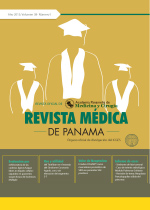Enfermedad de Huntington en población panameña, 2007-2021
Autores/as
DOI:
https://doi.org/10.37980/im.journal.rmdp.20221866Palabras clave:
Enfermedad de Huntington, epidemiología, incidencia, prevalencia, PanamáResumen
Introducción: La enfermedad de Huntington (EH) es un desorden neurodegenerativo autosómico dominante caracterizado por disfunción progresiva motora, cognitiva y psiquiátrica1. No se conoce la prevalencia de EH en Centro América (2-11). En Panamá no se han reportado estudios sobre esta Enfermedad. El objetivo es estimar la prevalencia de EH en población panameña.
Metodología: Se realizó un estudio descriptivo de casos con EH entre 2007 y 2021 en un hospital de tercer nivel. Se incluyeron individuos panameños, mayores de 15 años, un caso por familia, con cuadro clínico sugestivo, con o sin antecedentes familiares, resonancia magnética cerebral y prueba genética HTT positiva. Estos casos fueron incluidos en el Registro Nacional de Enfermedad de Huntington.
Resultados: Presentamos 11 casos índice, 6 femeninos. Se estima una prevalencia de 0.25 x 100000 habitantes, edad promedio 40 años (rango 23-63), media 43±12.4, la edad de inicio 29 años (rango 14-43), media 27±11.13, presentación juvenil 3 casos. Se detectaron 91 sintomáticos de 185 familiares, transmisión predominante paterna, todos heterocigóticos. Alelo normal entre 13-23 repeticiones de CAG, mientras que alelo mutante oscila entre 41 y 59 repeticiones de CAG.
Conclusión: Este es el primer reporte de la EH en población panameña, la prevalencia estimada es baja de 0.25 x 100000 habitantes. Estudios futuros deberán realizarse para conocer la prevalencia en Panamá y Centro América además de determinar el origen ancestral de esta población.
Archivos adicionales
Publicado
Número
Sección
Licencia
Derechos de autor 2022 Infomedic Intl.Derechos autoriales y de reproducibilidad. La Revista Médica de Panama es un ente académico, sin fines de lucro, que forma parte de la Academia Panameña de Medicina y Cirugía. Sus publicaciones son de tipo acceso gratuito de su contenido para uso individual y académico, sin restricción. Los derechos autoriales de cada artículo son retenidos por sus autores. Al Publicar en la Revista, el autor otorga Licencia permanente, exclusiva, e irrevocable a la Sociedad para la edición del manuscrito, y otorga a la empresa editorial, Infomedic International Licencia de uso de distribución, indexación y comercial exclusiva, permanente e irrevocable de su contenido y para la generación de productos y servicios derivados del mismo. En caso que el autor obtenga la licencia CC BY, el artículo y sus derivados son de libre acceso y distribución.






